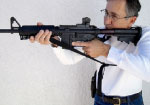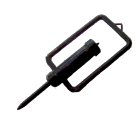When officers use their aerosol self-defense spray they make the same typical errors. The following lists ten of the common errors that can easily be avoided.
No Tactical Plan Prior to Deployment
When you use your OC what do you expect to happen? Will the suspect run? Will he fight? Will he collapse? Will he surrender? Will he ignore the chemical completely? Plan for each outcome before deploying it.
Spraying OC to Close
If you spray your OC when you are to close to a suspect you risk possible damage to eyes of  the suspect because of the "Hydrallic Needle Effect". The force of the stream in the first three feet is such that it could force the liquid into the soft tissue of the eyes.
the suspect because of the "Hydrallic Needle Effect". The force of the stream in the first three feet is such that it could force the liquid into the soft tissue of the eyes.
Because of the strength of the spray in close quarters it may splash back on you. This makes your actions unpleasant and more difficult to get the suspect in custody.
Spraying to close will put a lot of liquid in one spot. The liquid needs to evaporate before releasing the agent. So, it will slow down the reaction time for the agent to effect the suspect. It will not be a long delay, just micro seconds.
Spraying to Long and To Much
Slippery Suspect - A slippery suspect is very hard to handle. Besides if he is slippery from your OC you will get it on you when taking him into custody.
Drip from can causing Cross Contamination – Long sprays from your OC canister will result in an excess of liquid on the front of your canister. Make sure you tap the excess off before replacing into your belt holder. If you don’t you will be contaminating yourself.
Longer Decontamination - You want the suspect to recover so that you can process him in a reasonable amount of time. The more agent you on him the longer that recovery will be.
Two Burst Effects - Spray two short bursts targeting his lower chin and upper chest/neck area. If this doesn’t work think of another tactic because the chemical probably is not going to work on the suspect.
Not Moving While Spraying
Don’t stay in the same place you were when you used your OC. If the suspect wants to fight and his eyes go closed he will go for the spot he remembers you being before his he lost sight. If you are not there it will be easier for you to subdue him using unarmed tactics.
Inaccurate Deployment
You have to be able to hit the suspect where it will do some good. The chin, neck and upper torso are the best targets. You will need to get it in the suspect’s eyes to make it the most effective. That said aiming directly at the eyes can damage the eyes because of the hydraulic needle effect. Hitting the chin will get splash into the eyes and be very effective. If the suspect moves and gets it directly in his eyes at least you tried to miss that as a primary target.
Missing Your Target
If you miss your target hope your patrol partner is not behind or next to the suspect. He will not be very happy if you contaminate him. Are their innocent persons that you might hit? Although it won’t do any major injuries they will be upset and probably get a ride to a hospital for decontamination.
Moving in to Soon
 After deploying your agent wait a few seconds before taking the suspect into custody. Let the OC start working. OC effects in most people are not instantaneous.
After deploying your agent wait a few seconds before taking the suspect into custody. Let the OC start working. OC effects in most people are not instantaneous.
Cross Contamination
What’s downwind? What’s nearby? OC aerosol mostly stays on the suspect you spray. However, some of the agent that is aerosolized may spread with the wind. When you lay hands on the suspect it will be hard for you not to get some on your hands and maybe some that is still airborne. Be sure to wash your hands before you rub your eyes or touch other parts of your body.
Lack of Training
Everyone that carries OC aerosol should be properly trained. If you have not experienced the effects of OC, you should. That exposure will teach you to not panic if you happen to get contaminated by the OC you or your partner are using. It could be dangerous to you if you panic and keep your eyes closed. You can still fight with a face full of OC. You have to train your mind to ignore the pain from the OC.-
No Other Force Option Considered
 Using your OC is a type of force. As in all uses of force you want to make sure you have evaluated your force options. You want to use the least amount of force necessary to control a situation. OC is on the lower end of the force scale and is considered by most to be a non-lethal force option. When testifying in a civil trial you want to be able to tell the jury that you considered all your options and concluded that using your OC was most expedient option while minimizing potential injury to the suspect, innocent by-standers and yourself.
Using your OC is a type of force. As in all uses of force you want to make sure you have evaluated your force options. You want to use the least amount of force necessary to control a situation. OC is on the lower end of the force scale and is considered by most to be a non-lethal force option. When testifying in a civil trial you want to be able to tell the jury that you considered all your options and concluded that using your OC was most expedient option while minimizing potential injury to the suspect, innocent by-standers and yourself.





